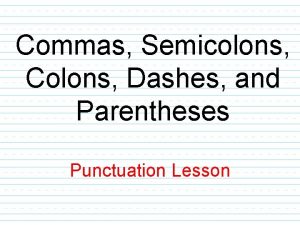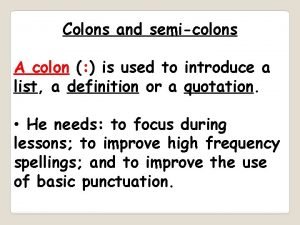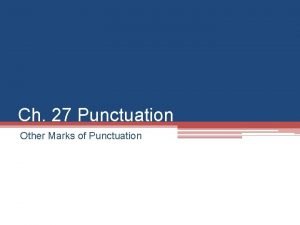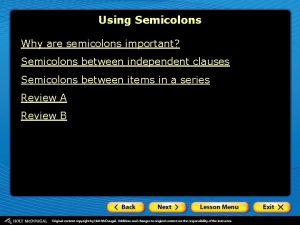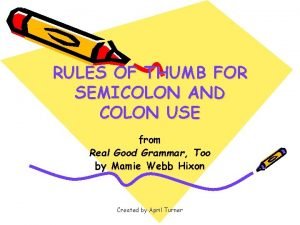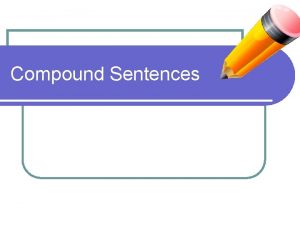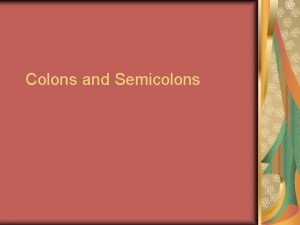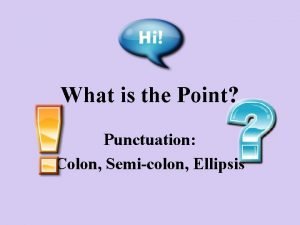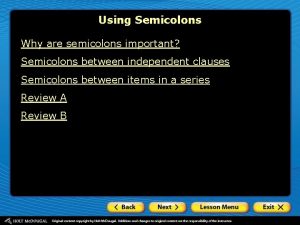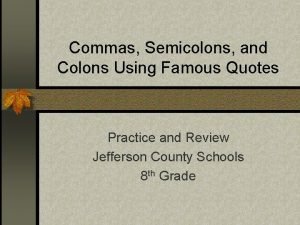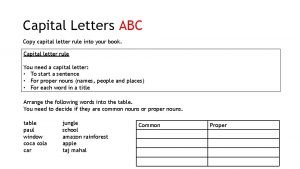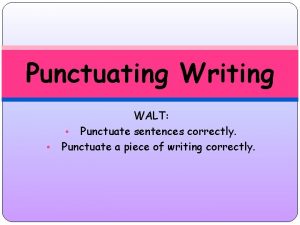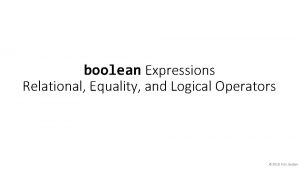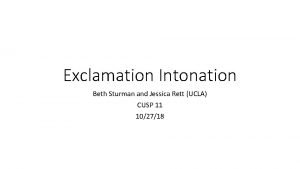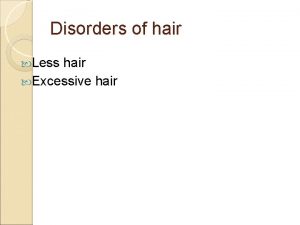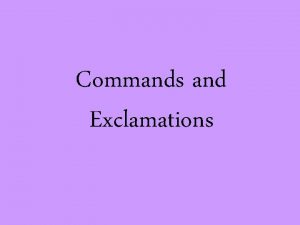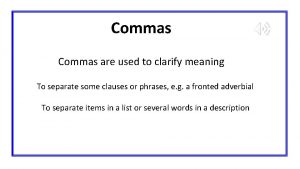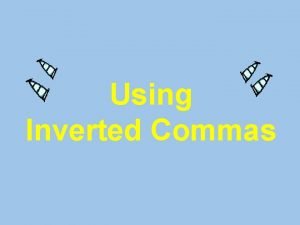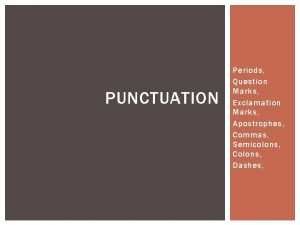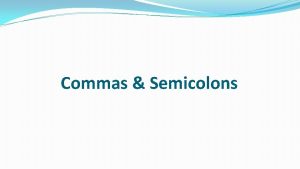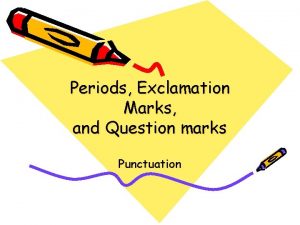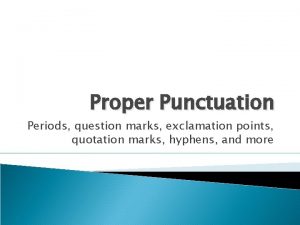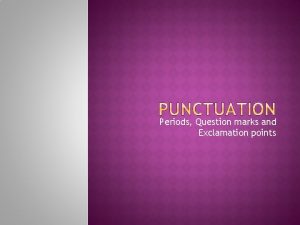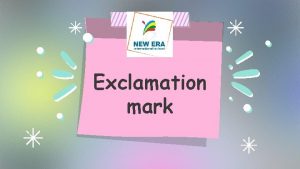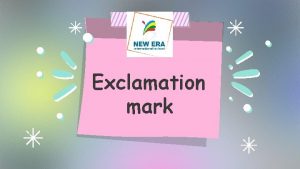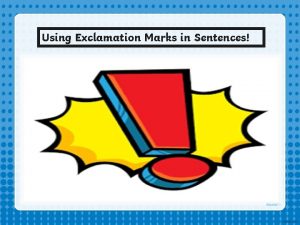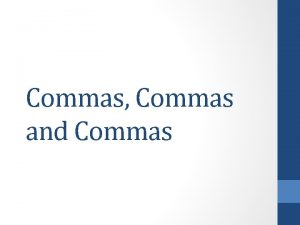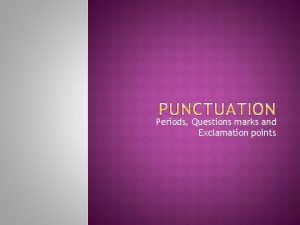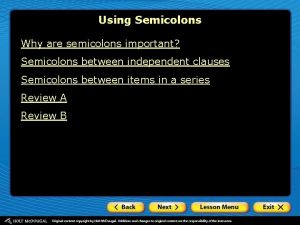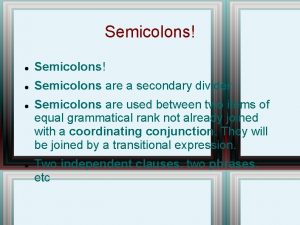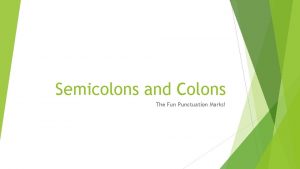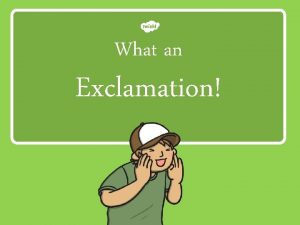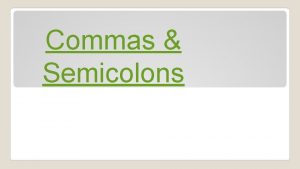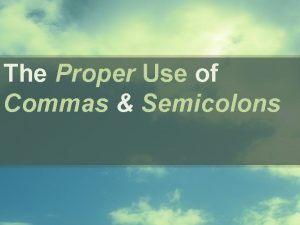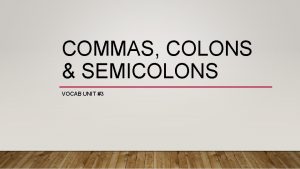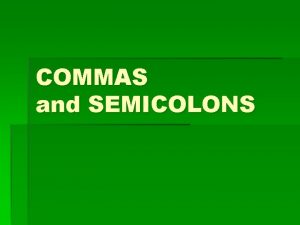Periods Question Marks Exclamation Points Semicolons Commas PERIODS





































- Slides: 37

• • • Periods Question Marks Exclamation Points Semicolons Commas

PERIODS The period says “STOP HERE”. Back in the olden days people did not use periods that must have been awfully confusing everything running together not knowing where one idea stops and another starts yikes makes for very difficult reading I’m sure glad we have periods now. (wow…breathe!) Be cautious of run-on sentences.

Let’s see what our literary pal, Charles, has to say… “It was the best of times, it was the worst of times, it was the age of wisdom, it was the age of foolishness, it was the epoch of belief, it was the epoch of incredulity, it was the season of Light, it was the season of Darkness, it was the spring of hope, it was the winter of despair, we had everything before us, we had nothing before us, we were all going direct to Heaven, we were all going direct the other way…” Charles Dickens, “A Tale of Two Cities”

Periods cont. USE A PERIOD AT THE END OF A COMPLETE SENTENCE. THIS RULE IS RIDICUOUSLY EASY. Other uses for periods: Use a period (decimal point) with money and percentages. $15. 50 55. 5% Use periods in URL addresses. My main email account is gmail. com, but I use yahoo. com too.

Use Periods in SOME Abbreviations This can be a little confusing because this is an area of punctuation that is changing rapidly. If in doubt, always consult a dictionary. Facts to Keep in Mind Months and days: Jan. , Feb. , Sept. , Mon. , Tues. , Fri. Titles: Mr. , Mrs. , Gen. , Dr. , Sen. , Addresses: Ave. , St. , Rd. , Blvd. Initials in people’s names: John F. Kennedy Measurements and time: lb. , oz. , hr. , mo. , yr. , ft. , in. , yd.

Do NOT use Periods for: Agencies, companies, and organizations: NATO, FBI, NFL, IBM, AT&T, YMCA Computer terms: RAM, DVD, PC, CD/ROM Tests: PSAT, IQ Radio and television stations: WQDR, KABC, ESPN Directions: NE, SW, NNE College degrees: BA, MD, DVM, JD States when written in all caps: NY, AL, SD, WI Technology and scientific abbreviations � mph (miles per hour) � mpg (miles per gallon) � ppm (parts per million) � STP (standard temperature and pressure) � UV (ultra violet) � O (oxygen) � Hg (mercury) � rpm (revolutions per minute)

Do you add a period, question mark, or exclamation mark if the sentence ends with an abbreviation that takes periods? Periods – no! Question marks and exclamation marks – yes. WRONG: Sarah woke up at 7: 00 a. m. . RIGHT: Sarah work up at 7: 00 a. m. WRONG: Your snoring woke me up at 2 a. m! RIGHT: Your snoring woke me up at 2 a. m. !

Question Marks Did you know? ? ? Use a question mark when asking a question. Simple, right? Here a few things to keep in mind… Indirect questions don’t take question marks. DIRECT QUESTION: Is today Monday? (straight forward question) INDIRECT QUESTION: I asked whether today is Monday. (This is a statement about a question. ) Well, now you do.

RIGHT: What in the World is a Homophone? is a very popular children’s book. If you have a question mark in the middle of a sentence, don’t capitalize the word after the question mark. WRONG: What in the World is a Homophone? Is a very popular children’s book. RIGHT: Will school be cancelled? Was on all the students’ minds. (Notice the question is in the title of the book; therefore, it becomes part of the sentence). RIGHT: Will school be cancelled? was on all the students’ minds. (Thoughts in the form of questions become part of the complete sentence).

Exclamation Points Use an exclamation point at the end of high-energy sentences. DELIGHT: Wow! This is the easiest rule in the whole book! URGENCY: Please help me! ANGER: Whatever! I don’t care! SURPRISE: This is amazing! DISTRESS: Oh no! EXCITEMENT: I made straight A’s on my report card! INTENSITY: I love you! LOUD NOISES: Bang! Crash! STRONG COMMANDS: Halt! Don’t go one step farther!

Notice how an exclamation point changes the tone of a sentence. Question or exclamation? Sometimes a sentence can go either way. LOW ENERGY: Mom said, “No, not now. ” RIGHT: How could you do that? HIGH ENERGY: Mom said, “No! Not now!” LOW ENERGY: Wake up. HIGH ENERGY: Wake up! ALSO RIGHT: How could you do that!

Avoid over-excited sentences! Some people use exclamation points all of the time! Every sentence just must be so exciting! Paragraphs look ridiculous when too many exclamation points are used! Even worse – double exclamation points!! In formal writing, NEVER…use double exclamation points! The reader knows not every sentence is THAT exciting!

The Semicolon It’s more than just a winky face. ; )


* The main function of a semicolon is to allow two closely related sentences to work together as one sentence; they get to be cozy in the same sentence, slightly divided by a semicolon rather than strongly divided by a period. * Use a semicolon between two complete sentences that are very closely related. RIGHT: My family is Catholic. We celebrate Christmas and Easter. BETTER: My family is Catholic; we celebrate Christmas and Easter. (Being Catholic and celebrating Christmas and Easter are closely related, and that relationship is emphasized by putting them in the same sentence. )

WRONG: I like oranges; not grapes. (Not grapes is not a complete sentence. Use a semicolon only between two complete sentences. ) RIGHT: I like oranges, not grapes. RIGHT: My dad is a coach at the university. We get free tickets to any sports event we want to see. (These two sentences are very closely related. ) BETTER: My dad is a coach at the university; we get free tickets to any sports event we want to see. WRONG: My dad is a coach at the university; we have some cousins who live in Texas. (Being a coach and having cousins in Texas are not closely related).

Use a semicolon before conjunctive adverbs that show a relationship between two complete sentences. WRONG: I bet you thought you wouldn’t have to learn another semicolon rule, however, you were wrong. Conjunctive Adverbs Also, besides, indeed, otherwise, therefore, in fact, meanwhile, in addition, consequently, nevertheless, next, still, finally, earlier, naturally, certainly RIGHT: I bet you thought you wouldn’t have to learn another semicolon rule; however, you were wrong. Be sure to include a comma AFTER the conjunctive adverb.

Use semicolons between clauses or phrases that contain a lot of commas. CONFUSING: Wesley like books about baseball, biplanes, and bagels, Thomas like books about antique cars, blimps, and rare fish, and Ruth like books about racehorses, dolls, and military jets. BETTER: Wesley like books about baseball, biplanes, and bagels; Thomas likes books about antique cars, blimps, and rare fish; and Ruth likes books about racehorses, dolls, and military jets.


Use a colon when you want to say “here comes an example” or “here’s what I’m talking about. ” This sentence is grammatically correct: I wonder if wolves actually wolf down their pizzas the way I wolf down mine. A colon is needed when you use these phrases: these are, the following, as follows, or these things. My favorite sports are the following: baseball, basketball, soccer, football, squash, racket ball, tennis, lacrosse, and golf.

Avoid writer’s cramp and take a break. Writing will resume shortly.

Use a colon before some lists. These are the ingredients: flour, eggs, sugar, milk, and chocolate. Use a colon before subtitles of books, articles, chapters, etc. The title of the book is Michael Jordan: Basketball Superman. Use colons with expressions of time. It’s 1: 15. Use a colon in the greeting part of a formal letter. To Whom It May Concern: Use a colon for biblical references. John 3: 16 Use a colon when referring to ratios. The ratio of oil to water is 3: 1 Use a colon after words such as caution, wanted, or note. Caution: slippery floor Wanted: part-time custodian Note: We’re finished with colons!

Break time is over!

Comma Sense Commas have many jobs within the English language and are used more than any mark of punctuation. Does it really matter whether your commas are in the right places? ABSOLUTELY!

Changing the location of your comma(s) can change the entire meaning of your sentence. SAY WHAT? The dog said my dad is scratching at the door and needs to go out for a walk. (HUH? ) BETTER: The dog, said my dad, is scratching at the door and needs to go out for a walk. DO YOU MEAN THIS: Billy Bob and Ken were playing their guitars. OR THIS: Billy, Bob, and Ken were playing their guitars.

Use a comma before a coordinating conjunction that introduces an independent clause (a clause that can stand alone as a COMPLETE sentence). Common coordinating conjunctions: and, but, for, so, yet

RIGHT: My sister’s name is Lily. My brother’s name is Lucas. (These are two complete sentences. ) BETTER: My sister’s name is Lily, and my brother’s name is Lucas. WRONG: I am very good in English, and in math. (and in math is not a complete sentence. ) RIGHT: I am very good in English and math.

CAUTION: A comma all by itself is NOT strong enough to separate two independent clauses. BE CAUTIOUS! This is a very common mistake. WRONG: We went to the beach last summer, I learned to surf. RIGHT: We went to the beach last summer. I learned to surf.

Use a comma after conjunctive adverbs (those are adverbs working as conjunctions – they link two sentences and show the two are related). * Refer to conjunctive adverb list. EXAMPLE: I thought I made a C on the test; however, I made a B.

Use a comma after MOST introductory phrases and clauses. **Whatever comes before the subject and verb is usually an introduction. EXAMPLE: Since my mother forgot to pack me a dessert, I ate your cookie. EXAMPLE: Since my mother forgot to pack me a dessert, I [subject] I ate [verb] your cookie.

Use commas when adjectives come after the noun. EXAMPLE: My language arts teacher, kind of heart and generous of spirit, will surely give me an A if I learn all of these commas rules.

Use commas in lists. Example: Please buy eggs, milk, bread, and cereal at the store. Use commas with cities and states. Example: Monroe, Michigan

Use commas with addresses. Caution: THERE IS NO COMMA between the state and the zip code. EXAMPLE: She lives at 225 Valley Road, Hope, Maine 04847. Use commas with direct quotations (what someone says). EXAMPLE: “There’s a big bug in the classroom!”, yelled Sofia.

Use commas when speaking directly to someone. EXAMPLE: Keith, it’s time to eat your breakfast. Use commas between consecutive adjectives (two or more in a row) describing the same noun. EXAMPLE: , ,

Use a comma before and after parenthetical expression (information of thoughts that are not absolutely essential). EXAMPLE: I reminded Mom, in case she’d forgotten, that I really want a digital camera for my birthday. Use a comma to show that two parts of a sentence are being contrasted. EXAMPLE: I ordered pizza, not lasagna.

Use commas before and after appositives (an appositive explains who or what the noun is). EXAMPLE: Our principal, John Rogers, gave a great speech. (The subject is principal. The appositive, John Rogers, tells more about who the subject is. )

IN CONCLUSION: Clearly, there are many comma rules to remember; however, if you remember one little trick you are likely to use commas correctly almost all of the time. That trick is that in many cases commas occur where you would pause for a little breath if you were saying the sentence out loud.
 Sentences with exclamation marks
Sentences with exclamation marks When to use commas semicolons colons and dashes
When to use commas semicolons colons and dashes Costa assessment answers
Costa assessment answers Semicolon vs colon
Semicolon vs colon Semi colon vs colon
Semi colon vs colon Chapter 27 punctuation answer key
Chapter 27 punctuation answer key Why are semicolons important
Why are semicolons important Semicolon in a sentence
Semicolon in a sentence Dash ks2
Dash ks2 Famous quotes with semicolons
Famous quotes with semicolons Compound complex sentence formulas
Compound complex sentence formulas What is semicolon
What is semicolon Semicolon vs colon
Semicolon vs colon Why are semicolons important
Why are semicolons important Famous quotes with semicolons
Famous quotes with semicolons When do we use question mark
When do we use question mark Quotations with question marks
Quotations with question marks Straddle positioning
Straddle positioning Points of parity and points of difference
Points of parity and points of difference Abc copy
Abc copy Sed regular expression examples
Sed regular expression examples Paragraph with punctuation
Paragraph with punctuation What is a exclamation
What is a exclamation Exclamation intonation
Exclamation intonation Direct indirect exercises
Direct indirect exercises Female virilization
Female virilization Command and exclamation
Command and exclamation Exclamation mark hairs
Exclamation mark hairs Exclamation mark pictogram whmis
Exclamation mark pictogram whmis Direct vs indirect questions examples
Direct vs indirect questions examples Closed questions
Closed questions What is a supporting question example
What is a supporting question example Contoh paraphrase
Contoh paraphrase What is a compelling question
What is a compelling question Example of situation producing question
Example of situation producing question Question word simple present
Question word simple present Using commas to separate clauses
Using commas to separate clauses When to put inverted commas
When to put inverted commas

